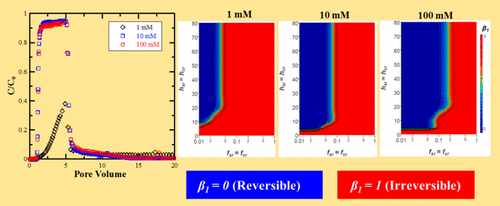Our official English website, www.x-mol.net, welcomes your feedback! (Note: you will need to create a separate account there.)
Contributions of Nanoscale Roughness to Anomalous Colloid Retention and Stability Behavior
Langmuir ( IF 3.9 ) Pub Date : 2017-09-11 00:00:00 , DOI: 10.1021/acs.langmuir.7b02445 Scott A. Bradford 1 , Hyunjung Kim 2 , Chongyang Shen 3 , Salini Sasidharan 4 , Jianying Shang 3
Langmuir ( IF 3.9 ) Pub Date : 2017-09-11 00:00:00 , DOI: 10.1021/acs.langmuir.7b02445 Scott A. Bradford 1 , Hyunjung Kim 2 , Chongyang Shen 3 , Salini Sasidharan 4 , Jianying Shang 3
Affiliation

|
All natural surfaces exhibit nanoscale roughness (NR) and chemical heterogeneity (CH) to some extent. Expressions were developed to determine the mean interaction energy between a colloid and a solid–water interface, as well as for colloid–colloid interactions, when both surfaces contain binary NR and CH. The influence of heterogeneity type, roughness parameters, solution ionic strength (IS), mean zeta potential, and colloid size on predicted interaction energy profiles was then investigated. The role of CH was enhanced on smooth surfaces with larger amounts of CH, especially for smaller colloids and higher IS. However, predicted interaction energy profiles were mainly dominated by NR, which tended to lower the energy barrier height and the magnitudes of both the secondary and primary minima, especially when the roughness fraction was small. This dramatically increased the relative importance of primary to secondary minima interactions on net electrostatically unfavorable surfaces, especially when roughness occurred on both surfaces and for conditions that produced small energy barriers (e.g., higher IS, lower pH, lower magnitudes in the zeta potential, and for smaller colloid sizes) on smooth surfaces. The combined influence of roughness and Born repulsion frequently produced a shallow primary minimum that was susceptible to diffusive removal by random variations in kinetic energy, even under electrostatically favorable conditions. Calculations using measured zeta potentials and hypothetical roughness properties demonstrated that roughness provided a viable alternative explanation for many experimental deviations that have previously been attributed to electrosteric repulsion (e.g., a decrease in colloid retention with an increase in solution IS; reversible colloid retention under favorable conditions; and diminished colloid retention and enhanced colloid stability due to adsorbed surfactants, polymers, and/or humic materials).
中文翻译:

纳米粗糙度对异常胶体保留和稳定性行为的贡献
所有自然表面都在一定程度上表现出纳米级粗糙度(NR)和化学异质性(CH)。当两个表面都包含二元NR和CH时,可以开发表达式来确定胶体与固水界面之间的平均相互作用能,以及胶体与胶体之间的相互作用。然后研究了非均质类型,粗糙度参数,溶液离子强度(IS),平均ζ电势和胶体尺寸对预测相互作用能谱的影响。在具有大量CH的光滑表面上,CH的作用得到了增强,尤其是对于较小的胶体和更高的IS。但是,预测的相互作用能谱主要由NR主导,这往往会降低能垒高度以及次要和主要最小值的幅度,特别是当粗糙度分数较小时。这极大地增加了静电不利的净表面上一次至二次极小相互作用的相对重要性,尤其是当两个表面都发生粗糙度以及产生较小能垒的条件时(例如,更高的IS,更低的pH,更低的Zeta电位和适用于较小的胶体尺寸)。粗糙度和Born斥力的综合影响通常会产生一个很浅的基本最小值,即使在静电有利的条件下,动能的随机变化也容易导致扩散去除。使用测得的zeta电位和假设的粗糙度特性进行的计算表明,粗糙度为许多先前归因于电立体斥力的实验偏差提供了可行的替代解释(例如,随着溶液IS的增加,胶体保留力降低;在有利条件下可逆胶体保留;以及由于吸附的表面活性剂,聚合物和/或腐殖质材料而导致的胶体滞留性降低和胶体稳定性增强)。
更新日期:2017-09-11
中文翻译:

纳米粗糙度对异常胶体保留和稳定性行为的贡献
所有自然表面都在一定程度上表现出纳米级粗糙度(NR)和化学异质性(CH)。当两个表面都包含二元NR和CH时,可以开发表达式来确定胶体与固水界面之间的平均相互作用能,以及胶体与胶体之间的相互作用。然后研究了非均质类型,粗糙度参数,溶液离子强度(IS),平均ζ电势和胶体尺寸对预测相互作用能谱的影响。在具有大量CH的光滑表面上,CH的作用得到了增强,尤其是对于较小的胶体和更高的IS。但是,预测的相互作用能谱主要由NR主导,这往往会降低能垒高度以及次要和主要最小值的幅度,特别是当粗糙度分数较小时。这极大地增加了静电不利的净表面上一次至二次极小相互作用的相对重要性,尤其是当两个表面都发生粗糙度以及产生较小能垒的条件时(例如,更高的IS,更低的pH,更低的Zeta电位和适用于较小的胶体尺寸)。粗糙度和Born斥力的综合影响通常会产生一个很浅的基本最小值,即使在静电有利的条件下,动能的随机变化也容易导致扩散去除。使用测得的zeta电位和假设的粗糙度特性进行的计算表明,粗糙度为许多先前归因于电立体斥力的实验偏差提供了可行的替代解释(例如,随着溶液IS的增加,胶体保留力降低;在有利条件下可逆胶体保留;以及由于吸附的表面活性剂,聚合物和/或腐殖质材料而导致的胶体滞留性降低和胶体稳定性增强)。



























 京公网安备 11010802027423号
京公网安备 11010802027423号